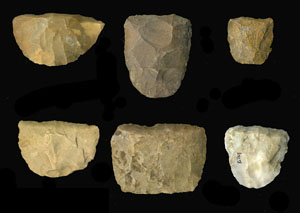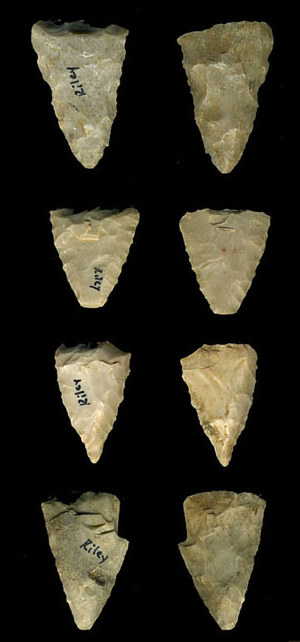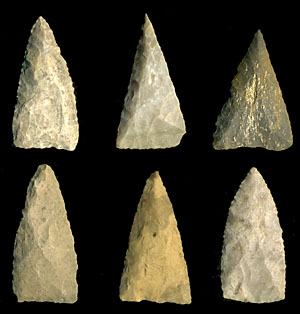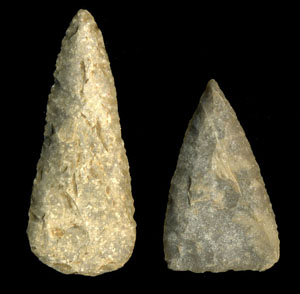Stone Tool Recycling:
A Key to Survival in Prehistoric South Texas
Within our modern world where acquiring new things is as easy as getting to the nearest mega-store, we often accumulate too much stuff over our lifetime. This love of stuff becomes a problem only when we find ourselves having to move and discover that every nook and cranny of our living space is filled with stuff. While we accumulated more and more things, we also tend to discard things immediately after they stop working and we rarely repair or re-use things once they are broken.
Imagine, however, a life of constant wandering in search of foodstuff within a world of scarce and unpredictable resources, and transport yourself back in time to the life of Native Americans in the South Texas Plains prior to the European contact, 500 years ago. Edible resources such as prickly pear, pecans, grass seeds and plant roots were available only in certain seasons and found in abundance only in good years. To make it even more difficult, sources of good quality tool-making stone could only be found in scattered patches throughout much of South Texas.
The scarcity of resources, combined with their dispersed nature, often forced groups to move frequently as different foods came available in different parts the region. The chances of finding good quality stone for tools varied from location to location and stone acquisition must have been a regular part of daily hunting and gathering activities. Frequent moves meant having to pick up everything you owned and moving it literally on your back or leaving it behind. This meant that the more stuff you had the more you had to carry around. Without burden animals (except dogs) to aid in the transport of your belonging, and with the prospect of having to move camp dozens of times each year in search of food and other resources, relocating was an arduous task that kept you from having much stuff.
One of the more ingenious solutions to this predicament devised by prehistoric hunter-gatherers was recycling. In the U.S. the recycling of aluminum cans, plastic and glass bottles has become part of our consciousness in the last few decades, but the native peoples of the South Texas Plains practiced it for thousands of years to cope with resource scarcity, unpredictability, and the realities of nomadic life. As archaeologists look at the prehistoric material culture left behind, it becomes clear that the native peoples perfected the practice of recycling. To the point that it likely permeated every aspect of their lives from the quantity of stuff they had, the design of the tools they used, the way they approached the repair and disposal of worn and broken tools, and the reuse of materials left at the locations of previous campsites.
In the South Texas Plains clear evidence of the importance of recycling can be seen in the stone tools. A similar strategy of use and reuse must have been followed with artifacts and building materials made of wood, leather, and woven fiber. Even cooking stones would have been reused until broken into small fragments. But the best-preserved evidence comes from stone tools.
Many archaeological sites in the region are marked by thousands and even tens of thousands of pieces of stone flaking debris. Yet, the former inhabitants made use surprisingly few types of stone tools to bring down a deer, butcher it, prepare its hide for clothing, fix dinner, and make tools and weapons for daily use. Upon microscopic examination, many of the recognized chipped-stone tools fall within a limited number of functional categories including projectile points to tip spear or arrow shafts, knives used to butcher and dismember prey, scrapers to prepare hides, and wood working tools such as adzes used to make weapons such as spears (darts) and throwing sticks (atlatls) and all manner of other kinds of wooden tools and construction materials. We can add a few specialized stone tools such as drills for reaming holes in leather and wood, and engravers used in decorating artifacts made of wood, bone and shell.
While the few “formal” stone tool forms require some shaping of a piece of flint to make them, it is likely that the bulk of the tools used in daily activities required almost no time to make and can be found "hidden" within the flaking debris. Simple flake tools required only a piece of debris of the right size and shape selected from a pile of flakes or chips to perform a task. Such tools required little effort to make and were routinely discarded immediately after their use, while the formal tools, that represented more effort to make and may have even been provided with a wooden handle, were kept as part of each individual’s tool kit and were likely transported from site to site.
Some flake tools were slightly shaped by minor edge trimming and are easy enough to recognize. But most flake tools were "expedient" tools, mere sharp flakes that were picked up, used for a few minutes, and discarded. The expedient flake tools can often only be spotted and confirmed through microscopic examination.
Projectile points, whether used to tip hand-trusted spears, darts thrown by throwing sticks, or arrows shot by bows, tend to be classified into named groupings known as types or styles based on their shape and other subtle characteristics. The most common South Texas Plains point types are: Abasolo, Catán, Desmuke, Matamoros, Refugio and Tortugas (see Unstemmed). Because of their consistency in shape, size and manner of flaking, several other tool forms also have acquired formal designations.
Other than projectile points, the most common formal tools in south Texas are adze (and gouge) forms including the following named types: Clear Fork, Nueces, Dimmit, and Olmos “bifaces” “gouges,” “distally beveled tools,” or “tools.” Most are bifacial tools, but unifacial forms also occur, particularly among the “Clear Fork” and Dimmit tools. Functionally, most seem to have been hafted woodworking tools. While use wear studies have found good evidence of heavy woodworking, they have also found other wear patterns left by contact with softer materials such as hides. Like so many tool forms in the region, these tools were no doubt adapted to different tasks as needs arose. See Woodworking Tool Tradition.
As men and women faced with making a living in a harsh environment, hunter-gatherers constantly batted with two competing objectives: 1) to have enough of the right tools to efficiently carry out a task when faced with it; and 2) to lighten the loads being carried from site to site during the annual migration cycle.
Having the right tool can make all the difference in finishing a job faster without unnecessarily wasting time and energy. Think about how much faster you can drive a nail into a 2 x 4 with a 16-ounce hammer compared to one weighing only half of that. And, if something goes wrong, you can pull the nail with the rip claw found on the hammer. However, a 4 lb blacksmith hammer can drive the same nail into the same plank in one or two blows, but it will not help you pull the nail and do you really want to carry it in your toolbox? Then, there are nails to pull, screws to drive, holes to drill, and wood to cut and plain, and before you know it your toolbox is so heavy that you can barely carry it from your truck to your job site.
The prehistoric inhabitants of South Texas Plains faced the same quandary each day and each time they had to break camp to move. Having a separate narrowly designed tool for the performance of each task would have meant making and carrying around a large number of tools in anticipation of planned and unforeseen needs. Clearly, this approach was undesirable—too much stuff carry around day-in, day-out. As a result, tools used for only one narrow purpose were rare in the tool kits of prehistoric peoples in the region.
Instead, hunter-gatherer strategy was to design a few generalized multi-functional tools that would suffice to help carry out many different tasks. While more generalized tool forms would have reduced the efficiency of some tasks, only a small number of tools had to be lugged around. Returning to the hammer analogy, if a hunter- gatherer of the South Texas Plains would had access to such technological wonders (and nails and the need to build permanent abodes), he or she would have chosen the hammer with the built-in rip claw rather than having to carry a hammer and a separate pry bar.
Back to prehistoric realities. Even stone projectile tips were used in both bringing down a prey and butchering it (and no doubt other tasks when need suited). This has been confirmed by use-wear studies that documented evidence of several different kinds of wear and edge damage on projectile points. And keep in mind that most of the multi-functional tools were probably made of wood such as the simple digging stick. Some tools may have had multiple working ends such a wooden throwing stick (atlatl) with a stone woodworking adze hafted to its end, as was a common practice among the aborigines of Australia. Such prehistoric Swiss Army knives would have allowed a reduction in overall weight while still allowing the performance of more than a single task with multi-purpose tools. Relying on simple flake tools for many daily tasks and using multi-purpose rather than specialized tools, were essential aspects of highly mobile hunter-gatherer lifestyle.
With tool design strategy and nomadic lifestyle limitations in mind, we turn back to the recycling tradition. South Texas hunter-gatherers routinely resharpened their tools so extensively that when the tools were finally disposed of, little if any usable material was left. They also relied extensively and systematically on recycling broken tools. In other words, failed stone tools were often reworked into different, but fully functional tools. For instance, a broken knife or a dart point tip could be turned into a small adze form, such as an Olmos biface. While it is likely that such stone tool recycling ordinarily took place soon after the original tool failure, some recycling occurred long after the original failed tool was discarded. Later peoples, hundreds and even thousands of years later, picked up old spent tools and found a new use for them.
Prehistoric peoples living in South Texas not only used and reused their tools until very little was left of them, but also employed subtle methods of resharpening a tool that reduced the probability of tool failure, even in the face of heavy use and extensive resharpening. A modern example will help illustrate this subtle yet ingenious approach to tool resharpening. The steel-bladed tools we use every day such as the knives and scissors inevitably become dull during use, and some of us regularly resharpen them to renew the edge.
The exact same thing happened with prehistoric chipped-stone tools, and stone dulls much faster than steel. Sharp edges were important not only to chipped-stone knives, but also projectile points. The sharper the edges of the point, the more internal bleeding it could inflict once it penetrated the body cavity of a prey. Therefore, projectile points were routinely resharpening to maintain the advantage of sharp blade edges.
Two general approaches to resharpening can be observed on projectile points, both usually involving the removal of a series of adjoining flakes from one face of the artifact at a time. In the invasive resharpening technique, resharpening flakes removed by pressure flaking extended onto the face of the specimen, removing both a portion of the worn edge as well as thinning the cross-section of the point. The resharpened artifact was both slightly narrower and slightly thinner as a result, and somewhat more prone to breakage. In the beveling technique, short flakes were removed by pressure nearly perpendicular to the worn edge, these flakes were not intended to extend onto the face of the artifact. As a result, the resharpened artifact was slightly narrower but not significantly thinner than what one started with.
While both techniques accomplished the goal of creating sharp edges, the beveling technique resulted in a specimen that was not weakened significantly through resharpening. The thicker blade cross-section contribute to increased breakage resistance that, in turn increased the life of the artifact. Having tools that lasted longer would have been advantageous for mobile peoples living in a land where tool-making stone was reasonably scarce and often of poor quality. It is no surprise that many of the projectile point forms used over thousands of years in South Texas tended to be resharpened through beveling.
In addition to choosing an advantageous resharpening technique, South Texas hunter-gatherers also devised a process whereby worn or broken tools were reworked into new functional forms. Tools-in-the-making that failed during the initial stages of manufacture could also be turned into new smaller tool forms useful for performing a different set of tasks. When necessary and when possible, new tools of relatively large size and symmetrical design would be made from freshly acquired raw materials, and the use-recycling-reuse cycle began anew.
Discarded or worn-out beveled dart points were sometimes made into Olmos tools and other small adze forms that are typical of South Texas tool kits. Olmos tools have beveled lateral edges, and in some instances, impact broken pointed proximal ends. Neither of these characteristics has much to do with their use as scrapers, gouges and adzes. Instead these characteristics trace the origin of the Olmos tool to triangular Tortugas or Matamoros projectile points that were either broken in use and/or had been exhausted and were subsequently re-cycled through reworking into new tool forms, such as scrapers, gouges and adzes.
Similarly, typically Dimmit and Nueces tools tend to be begin life as unifaces made from a thick flake that had at least one flat surface. This flat surface usually became the flat under-side of the tool that allowed it to glide relatively smoothly against the raw material (mostly wood) being worked. Large collections of these tools, however, often contain a few bifacially manufactured tool forms. In the case of some of these bifacial specimens, the flaking patterns (i.e., the size of the flakes, their orientation) suggest that they started out as large bifaces that were broken either during manufacture or perhaps use. Rather than discarding these failed fragments, the break-faces are re-flaked from one face to create the bevel typical of Dimmit and Nueces tools. These reworked, recycled tools tend to have a strongly bi-convex or lenticular cross-section reflective of their bifacial origins rather than a plano- convex or only slightly bi-convex cross-section, as is typical of most Dimmit and Nueces tools.
The final aspects of tool collections from the South Texas Plains that point to an on-going strategy of recycling with lengthy roots are represented by artifacts with clear signs of re-flaking well after the time of their original manufacture, and the presence of chronologically inconsistent point styles within sites.
Patina is a change in the coloration of the fresh surface of a stone artifact that begins immediately after a flake is removed from it. It may be the product of a combination of factors including dehydration (e.g., loss of water), weathering and mechanical factors such as aeolin sand-blasting from wind-borne sand and grit. Although patina builds up at different rates, in general the longer it has been before a flake surface has been flaked, the more pronounced the patina will be. Often patinated tools take on a white or cream-colored appearance with increased age. And patina starts on the surface of the artifact and gradually penetrates into the interior . A fresh flake removed from a patinated surface will expose as yet unpatinated material that will typically have a darker color from that present on the rest of the surface. This change in color between flake scars created at different times is one of the clear signs of artifact recycling.
A second indication of ancient artifact recycling consists of the recovery of projectile points from archaeological contexts that do not fit the chronological age of the component. Conditions for the repeated burial of archaeological sites are unfavorable throughout much of the South Texas Plains, and therefore few archaeological sites have provided archeologists with buried stratified components. This, combined with the relatively poor preservation of organics in open sites that could be used for radiocarbon dating, has made it difficult to develop a refined regional projectile point chronology. This goal is further complicated by the apparent fact that prehistoric hunter-gatherers sometimes used old campsites as sources for replacement tools and tool-making parts.
While clear examples of differentially patinated artifacts are not very common, sites with predominantly Late Prehistoric artifact assemblages often contain a few specimens that have earlier origins. For instance, size is the principal difference between Tortugas points that date to as early as the onset of the Middle Archaic (ca. 2500 B.C.) and Matamoros points that date as late as the end of the Late Archaic (ca A.D. 800). While the two point styles are very similar in shape, there are subtle yet noticeable differences between them owing to technological limitations imposed by size differences in the pieces of chert or flint used in their manufacture. The manufacture of the smaller Matamoros point began with a relative small flake that could not be flaked in quite the same manner as the large flakes used in the making of Tortugas points. However, as the large Tortugas points are resharpened and decrease in size, some of the indicators showing their original larger size (i.e., remnants of large basal thinning flake scars, maximum thickness) remain indicative of their original larger size even when their smaller forms that may otherwise be mistaken as Matamoros points.
The reworking of these larger point forms into smaller types and their occurrence within archaeological collections that contain primarily late (i.e., Late Archaic) materials may be indicative of the systematic use of artifacts abandoned during Middle Archaic times for the manufacture of Late Archaic replacement tools through recycling and reworking. The presence of Middle Archaic points in Late Archaic assemblages may also indicate that the deposits are a mix of artifacts from both time periods or that the Tortugas forms are very long-lasting in South Texas.
Contributed by Dr. Steve Tomka, former director of the Center for Archaeological Research (UTSA), a TBH partner organization.
Sources:
Brown, K.M., D.R. Potter, G.D. Hall, and S.L. Black
1982 Excavations at 41LK67, A Prehistoric Site in the Choke Canyon Reservoir, South Texas. Choke
Canyon Series, vol. 7. Center for Archaeological Research, University of Texas at San Antonio.
Hester, T.R.
1995 The prehistory of South Texas. Bulletin of the Texas Archeological Society 66:427-459.
Hester, T.R., L.White, and J. White
1969 Archeological Materials from the Oulline Site (41LS3) and Other Sites in La Salle County, Texas.
Texas Journal of Science 21:131-166.
Mahoney, R.B., R.P. Mauldin, and S.A. Tomka
2002 Archeological Data Recovery Excavations along Becerra Creek (41WB556), Webb County, Texas. Center for Archaeological Research, Archaeological Survey Report, No. 321. University of Texas at
San Antonio.
Nunley, J.P., and T.R. Hester
1965 Preliminary Archeological Investigations in Dimmit County, Texas. Texas Journal of Science 18:233-253.
Turner, E.S., and T.R. Hester
1993 A Field Guide to Stone artifacts of Texas Indians. Texas Montly Field Guide Series.
Second Edition. Gulf Publishing Company, Houston.
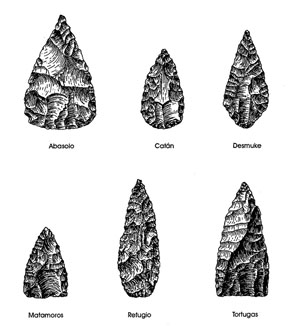
|
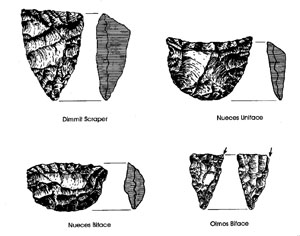
|

|

|
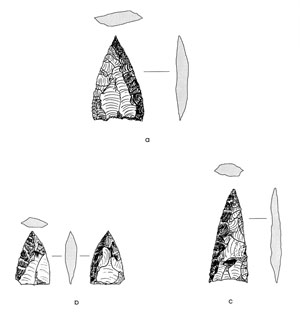
|

|
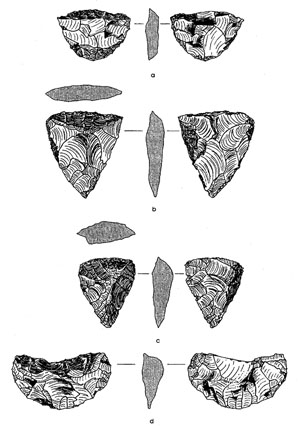
|

|
